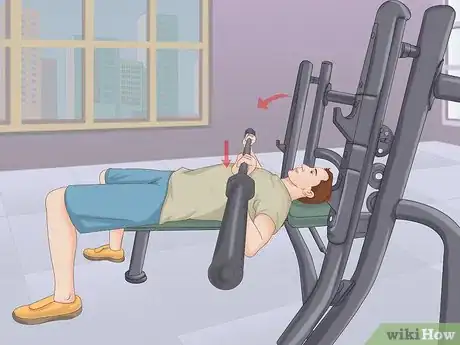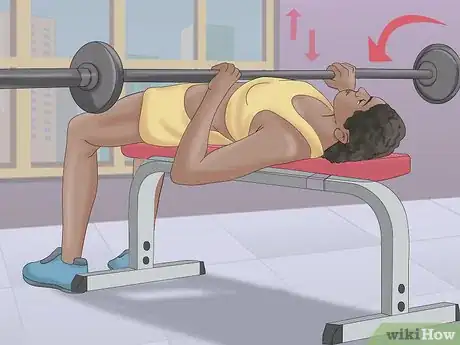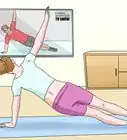This article was co-authored by Michele Dolan. Michele Dolan is a BCRPA certified Personal Trainer in British Columbia. She has been a personal trainer and fitness instructor since 2002.
This article has been viewed 858,817 times.
Do you want to build up that chest of yours? What about those skinny arms? Bench pressing targets both of these areas, as well as your shoulders, and you will see results quickly as long as you give yourself ample rest between your workout sessions.
Steps
Mastering the Basic Bench Press
-
1Begin by lying flat on the bench, with your body in a natural and relaxed position. Make sure that you are not holding your shoulders in an awkward position. Be sure to have a natural spinal curve. You do not want to have your lower back flat on the bench, but you do not want to force it to curve too much either. Instead, opt for a comfortable and natural position.[1]
- You should have your feet flat on the ground, shoulder-width apart, and your shoulders touching the bench.
- Do not lift on a "cushiony bench" if you are a heavy lifter. When the bar and plates weigh more than 200 pounds plus the weight of your upper body, your shoulders will disappear into the bench and cause neck strain.
- Choose a proper bench that fits your shoulder width. A narrow bench is unstable and a wide bench prevents the upper arm from bending back.
-
2Put your arms straight out to either side of you, and then bend your elbows, bringing your hands up to touch the bar. This is where you should position your hands. They should be about shoulder-width apart. Use the smooth rings in the bar as a reference for even hand placement.[2]
- Where you position your hands will affect which muscle group you work most. Widen your grip slightly to increase the amount of pectoral muscles involved in this exercise, and bring your grip in slightly to increase your triceps involvement. For a standard bench press, opt for the normal grip.
Advertisement -
3Begin with just the bar weight to warm up before heavy lifting. Lift the bar off the rack and position it directly above the middle of your chest. Inhale as you lower it down, gently touching your chest — the middle of the sternum — with the bar. Do not bounce the bar off your chest, as this can cause serious injury and promotes bad form. Begin to exhale as you push the bar up and away from your body. Extend your arms to just under full extension. Repeat this for eight repetitions as your first set.
- Lift with a bar that has a little flex but is not "whippy". A stiff bar can be uncomfortable to lift with. All bars are made of metal and relatively stiff, but a bar with some flex feels better on the joints. The salesperson at the store will give you the right bar for your bodyweight, based on the formula for bodyweight and bench press. Generally, a beginning or intermediate lifter is not going to lift over his bodyweight plus 50%.
- Examine your goals when choosing a bar. For setting a personal record or a state record and above, use a bar with a standard diameter of 1 1⁄16 inches (2.7 cm). If not concerned with records, a thicker bar does not dig into the palms and is more comfortable. A thicker bar increases the distance of the lift and decreases the amount that can be lifted. A 1/8 (or 1/16) inch increase in bar diameter has a noticeable difference in feel and stability.
-
4Rack the bar and add weight. Always use weight clips to prevent the weights from sliding off the bar in the event that you lift unevenly, do not lift without them. The bar by itself weighs 45 pounds. You will want to increase by five to ten pounds at a time until you find a comfortable weight.
- Practice extra caution if tall. Tall lifters with wide grips should use care not to crush their hands when racking the bar. Weight benches were made for someone tall (6 feet tall and not for a lifter 6 feet 8 inches tall). Tall lifters should not use an extra wide grip. An extra wide grip strains the wrist with excessive radial flexion. Close and wide grips can make the wrist more prone to injury.
- Avoid using the thumbless grip. If the bar slips off your hands, it would be disastrous. When being spotted by spotters and by a spotting device the thumbless grip is not as dangerous, but the spotting device has to be very, very solid. The thumbless grips is easier on the wrist and conducts power to the bar more directly (you can lift more). Use chalk with both grips. There are lifters who will use the thumbless grips despite the possible danger.
-
5Be sure to have a spotter to help you whenever you lift a heavy weight. You never want to drop the bar on yourself. You also want to be able to max out and be able to recover when you no longer can lift the bar. A spotter will be able to help you recover from your final press.[3]
-
6Lift the bar up, slowly bring it down to just above your sternum, and explode upward for one rep. Pay attention to your form as you add more weight. It's easier to bend your wrists, bounce the weight off your chest, and exhibit other "no-nos" when trying to lift big. You'll gain more muscle and strength lifting the right form and lower weight than you will lifting with higher weight and the wrong form.
- Lifters generally do between 8 and 12 reps (also called "repetitions") and 3 to six sets (one set is the maximum numbers of reps you give yourself).
-
7Drink plenty of water and take at least two minute breaks between each set. Water will help you stay hydrated and allow your muscles to function at high capacity, giving you an overall better workout.[4]
-
8Rest according to how you feel between sets. Some guides say the ideal rest time between sets is 90 to 120 seconds.[5] While this is perhaps a good general guide for increasing muscle mass, it may not be ideal for you as an individual. You probably don't want to overshoot the 2-3 minute range, but you don't want to rush yourself into lifting thin.
- If your ultimate goal is gaining muscle and mass, you're going to want to shock your body. How you do this is up to you. It can mean cutting down on rest time, increasing poundage on lifts, supersetting, etc. As long as you manage to keep pushing your body physically, you will notice a difference.
Getting More out of Your Bench Press
-
1Hone your technique. It's been said before, but it's worth repeating. Poor form and more weight won't get you lifting more; proper form and less weight will. Here is a short list of several things you should pay attention to while you bench:
- Squeeze the bar tightly to activate your triceps. Activating your triceps will ultimately help you lift more.
- Use your legs to create a solid base. Think of yourself as driving your back and traps into the bench, giving your chest and arms a foundation to push off against.
- Lift the bar up and down in a straight line. If lifting causes you to wobble back and forth when you bring the bar up and down, you are probably lifting too much weight. Switch to lower weight and practice proper form.
-
2Tone your back and triceps. Muscles in the body are interconnected. That means that to fully tone your chest with the bench press, you need to pay attention to your triceps and back. One reason lifters often reach a plateau in weight is that they forget to work out their triceps, which help power the bench press.
- To tone your triceps, make your grip smaller on the bench press. Also try to work out the triceps with dips, skull-crushers, and overhand cable extensions.[6]
- To tone your upper back, try barbell rows, which happen to be the exact opposite of the bench press. With good form, this exercise should strengthen your back significantly.
-
3Eat better and more to gain muscle. The secret to gaining muscle mass is working out and eating right. Take your body weight in pounds and multiply that number by 18. This is the number of calories you should try to get into your body over the course of your day.[7] Remember also to get a good balance of protein, carbohydrates, and fats. Shoot for 25-40% calories from protein; 15-40% calories from fat; and 35-45% calories from carbohydrates.
-
4Make sure both arms are roughly equal in strength. If you spend any amount of time watching others bench press, what you'll notice is that most people are a bit stronger with one arm — usually their dominant. What keeps many people at a plateau is their weak arm or side, as you can only lift as much as this arm will let you. To overcome this temporary limitation, work out your weak side more than normal. When either arms or sides are strong enough to work in tandem while bearing equal weight, watch your bench press skyrocket.
-
5Switch it up around the chest. If the only chest exercise that you perform is the bench press, your body will adapt quickly. To take your bench press to the next level, you are going to have to find different exercises for your chest. Try them out to see what works for you. Even slight differences in exercises can yield drastic results. Here are some additional chest exercises that you can try to max out your bench press:
- Dumbbell flyes
- Barbell incline/decline
- Pushups
- Chest press (incline or regular)
- Cable extensions
Expert Q&A
-
QuestionHow many times a week should I do bench presses?
 Michele DolanMichele Dolan is a BCRPA certified Personal Trainer in British Columbia. She has been a personal trainer and fitness instructor since 2002.
Michele DolanMichele Dolan is a BCRPA certified Personal Trainer in British Columbia. She has been a personal trainer and fitness instructor since 2002.
Certified Fitness Trainer Twice is good and plenty if you are working to failure. Work out the back legs and abs on other days if you want.
Twice is good and plenty if you are working to failure. Work out the back legs and abs on other days if you want. -
QuestionWho holds the bench press record?
 Michele DolanMichele Dolan is a BCRPA certified Personal Trainer in British Columbia. She has been a personal trainer and fitness instructor since 2002.
Michele DolanMichele Dolan is a BCRPA certified Personal Trainer in British Columbia. She has been a personal trainer and fitness instructor since 2002.
Certified Fitness Trainer It depends on the person's weight, gender and age. Check out this link for more information: bench-pressing.com/bench-press-world-records
It depends on the person's weight, gender and age. Check out this link for more information: bench-pressing.com/bench-press-world-records -
QuestionI am now starting to bench press so what should I do first?
 Michele DolanMichele Dolan is a BCRPA certified Personal Trainer in British Columbia. She has been a personal trainer and fitness instructor since 2002.
Michele DolanMichele Dolan is a BCRPA certified Personal Trainer in British Columbia. She has been a personal trainer and fitness instructor since 2002.
Certified Fitness Trainer The bench press can be started by anyone with a few dumbbells. Lie down on your back, on a bench or even the floor if you do not have a bench. Start by holding the weights at chest level and slowly push upwards, hands away from chest. Pause at your peak range of motion, then lower the weights back to chest level. Repeat.
The bench press can be started by anyone with a few dumbbells. Lie down on your back, on a bench or even the floor if you do not have a bench. Start by holding the weights at chest level and slowly push upwards, hands away from chest. Pause at your peak range of motion, then lower the weights back to chest level. Repeat.
Warnings
- Make sure you have a stable surface to lift from.⧼thumbs_response⧽
- Always have someone spot you in case your hands slip or you lift a weight that is too heavy.⧼thumbs_response⧽
- Make sure you have had some training in weightlifting before you begin working out frequently.⧼thumbs_response⧽
- Do not continue this exercise if you experience any pain. Consult your doctor if pain continues.⧼thumbs_response⧽
- Do not lift excessively heavy weights when you are starting, as they can cause injury.⧼thumbs_response⧽
- Keep your buttocks in contact with the bench.
- Breathe properly. Inhale as you lower the bar and exhale as you lift the bar on the way up. You will both decrease your risk of injury and increase your strength using this proper breathing technique.
⧼thumbs_response⧽
Things You'll Need
- Weightlifting training
- Barbells
- Weights.
- A weight Bench.
- A spotter.
References
- ↑ https://www.bodybuilding.com/content/how-to-bench-press-layne-norton-complete-guide.html
- ↑ https://www.bodybuilding.com/content/how-to-bench-press-layne-norton-complete-guide.html
- ↑ https://www.mensjournal.com/health-fitness/the-right-way-to-fail-a-bench-press-w493237/
- ↑ https://www.active.com/nutrition/articles/how-to-hydrate-before-during-and-after-a-workout
- ↑ http://www.bodybuilding.com/fun/phano62.htm
- ↑ http://www.askmen.com/top_10/fitness/top-10-tricep-exercises.html
- ↑ https://health.gov/dietaryguidelines/2015/guidelines/appendix-2/#footnote-1
About This Article
To do a bench press, lie on your back on the bench with your feet flat on the ground. Put your arms straight out to your sides, then bend your elbows up towards the ceiling and grab the bar. Lift the bar with the weights and slowly bring it down to your chest. Then push it upward again, being sure to avoid bending your wrists or bouncing the weight off your chest. Repeat this 10 times and then take a rest before trying another set. If you want to learn more from our Personal Trainer co-author, like how to have someone spot for you while you're lifting, keep reading the article!













-Step-12.webp)
















-Step-12.webp)





































